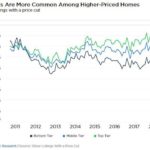According to Forbes and Zillow
“The share of pricier homes available for sale at a discount from their original list price is growing, even as sellers of less-expensive homes seem somewhat less willing to consider a price cut.
In June, 14.2 percent of all U.S. homes listed for sale on Zillow had at least one price cut, up slightly from 13.4 percent in June 2017, but more or less within the roughly 12 to 14 percent range in which the data have hovered since mid-2013. Still, price cuts could be increasingly more common in coming months if more recent trends continue to hold. Since the beginning of the year, the share of listings nationwide with a price cut increased 1.2 percentage points, the greatest January-to-June increase ever reported, and more than double the January-to-June increase last year.
And as home value growth begins to show signs of slowing in a number of large markets, the local price cut phenomenon is more pronounced. In two-thirds of the nation’s 35 largest housing markets, the overall share of listings with at least one price cut has risen over the past year.
In San Diego, 20 percent of all listings had a price cut in June 2018, up from 12 percent a year ago. In Seattle, 12 percent of all listings had a price cut in June, the greatest share since October 2014. Portland, Sacramento, Calif. and Riverside, Calif., were also among the markets that experienced an increase in the share of listings with a price cut in June compared to a year ago.
And the overall increase in the share of homes with a price cut appears to be driven by trends in the upper reaches of the market. Since the beginning of the year, the share of higher-priced listings with a price cut – those priced in the top one-third of all homes listed for sale – rose 0.9 percentage points, to 16.2 percent. Over the same time, the share of lower-priced listings with a price cut (those priced in the bottom one-third of all homes) fell 0.1 percentage points, to 11.2 percent. And the national trend holds in a number of notable local markets, as well. Since the beginning of the year, higher-priced listings have seen a disproportionately large increase in price cuts in 23 of the 35 largest metros analyzed by Zillow. And in June, a larger share of top-tier listings had at least one price cut than bottom-tier listings in all of the 35 largest markets.”
What seems to be happening in the national market is a little different than our local market, where homes in the top end of the market still seem to be moving at a quick rate. When this is happening the homes are not on the market long enough to be forced in to a price drop. That doesn’t mean they are selling for full price (several are though), but a contract is entered quick enough to undercut the need for a price drop.
The story continues
“U.S. home values rose 8.3 percent over the past year to a median home value of $217,300. While home value growth isn’t slowing down nationally, it is slowing in some of the nation’s hottest housing markets. In almost half of the 35 largest markets, home value growth is appreciating more slowly now than at the beginning of the year. The median home value in Seattle rose 11.4 percent over the past year, but the annual growth rate was close to 14 percent at the beginning of the year.”
About the Author of quoted article
Zillow
Svenja Gudell
I’m the Chief Economist at Zillow, where I lead an economic research team that is a recognized voice of impartial, data-driven economic analysis on the U.S. housing market. We produce monthly reports on housing trends for more than 450 metro areas, with data often available down to the ZIP-code level. We also publish original research on various real estate topics, ranging from rental and mortgage affordability, negative equity and forecasting, to policy, generational and mortgage research. Prior to joining Zillow, I did economic, financial and strategy consulting for Analysis Group and was an Assistant Economist in the Research Group of the Federal Reserve Bank of New York. I have a Bachelor of Arts in economics from om the University of Rochester, a Master of Arts in economics from New York University, a Master of Science in business administration from the University of Rochester, and a Ph.D. in finance from the University of Rochester



Leave a Reply